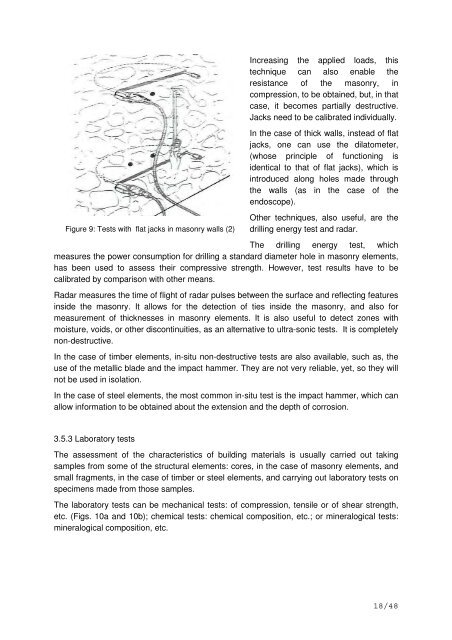As tests are, in general, very expensive, and carrying <strong>the</strong>m out can affect <strong>the</strong> cultural value<strong>of</strong> <strong>the</strong> building, <strong>the</strong> number and <strong>the</strong> place in which <strong>the</strong>y are planned to be per<strong>for</strong>med shouldbe considered sensitively. As a rule, <strong>the</strong> tests to be carried out will be based on a clear vision<strong>of</strong> <strong>the</strong> phenomena <strong>for</strong> which characterization or understanding is relevant.In <strong>the</strong> planning <strong>of</strong> <strong>the</strong> program <strong>of</strong> tests, two phases will, in general, be considered: <strong>the</strong> firstone, in which <strong>the</strong> aim is <strong>the</strong> acquisition <strong>of</strong> <strong>the</strong> primary in<strong>for</strong>mation; and <strong>the</strong> second one, inwhich <strong>the</strong> aim is to refine <strong>the</strong> in<strong>for</strong>mation obtained during <strong>the</strong> first phase, carrying out anadditional number <strong>of</strong> tests or more specific tests.After carrying out <strong>the</strong> tests, <strong>the</strong> results obtained will be carefully analysed. In particularsituations, alternate methods <strong>of</strong> tests will be used, and <strong>the</strong>ir results compared, <strong>for</strong> calibration.The tests can be non-destructive (or slightly intrusive), when <strong>the</strong>y have a negligible influenceon <strong>the</strong> building, or destructive (in any way), o<strong>the</strong>rwise.Non-destructive tests (“NDT”) are, obviously, <strong>the</strong> preferable ones <strong>for</strong> heritage buildings. Ifnon-destructive tests will not be sufficient, destructive tests will be considered, but <strong>the</strong>y willbe carried out only after a cost-benefit analysis.In this analysis, <strong>the</strong> global cost will be <strong>the</strong> cost <strong>of</strong> <strong>the</strong> tests plus <strong>the</strong> eventual loss on <strong>the</strong>cultural value <strong>of</strong> <strong>the</strong> building due to <strong>the</strong> carrying <strong>of</strong> <strong>the</strong> tests, and <strong>the</strong> benefit will be <strong>the</strong>eventual reduction on <strong>the</strong> size <strong>of</strong> <strong>the</strong> intervention due to <strong>the</strong> improvement in <strong>the</strong> quality <strong>of</strong> <strong>the</strong>in<strong>for</strong>mation.3.5.2 In-situ testsIn <strong>the</strong> case <strong>of</strong> masonry elements, <strong>the</strong> available most common non-destructive techniques <strong>for</strong>in-situ tests are ultra-sonic tests and analysis with endoscope; flat jack tests are also veryuseful, but <strong>the</strong>y are slightly destructive.The ultra-sonic device measures <strong>the</strong> speed <strong>of</strong> a sonic pulse through <strong>the</strong> masonry element. Itallows <strong>for</strong> in<strong>for</strong>mation to be obtained about <strong>the</strong> stiffness and <strong>the</strong> resistance <strong>of</strong> <strong>the</strong> masonry,but in a qualitative way, only. It also allows <strong>for</strong> in<strong>for</strong>mation about <strong>the</strong> presence <strong>of</strong> voids oro<strong>the</strong>r discontinuities. It is completely non-destructive.The endoscope (fibre optic viewing device) allows <strong>the</strong> observation <strong>of</strong> <strong>the</strong> interior <strong>of</strong> masonryelements and <strong>the</strong> conditions <strong>of</strong> <strong>the</strong> materials around holes drilled in those elements. It is veryeffective, causing minor damage <strong>for</strong> a moderate cost.The flat jack technique consists <strong>of</strong> <strong>the</strong> <strong>for</strong>mation <strong>of</strong> small slots in <strong>the</strong> masonry, in which flatjacks <strong>of</strong> small depth are introduced (Fig. 9).By measuring <strong>the</strong> applied pressures, as well as <strong>the</strong> de<strong>for</strong>mations between <strong>the</strong> slots, thistechnique allows <strong>the</strong> measurement <strong>of</strong> <strong>the</strong> stress-strain relationships <strong>of</strong> <strong>the</strong> masonry between<strong>the</strong> slots, and so <strong>the</strong> obtaining <strong>of</strong> its modulus <strong>of</strong> elasticity.17/48
Increasing <strong>the</strong> applied loads, thistechnique can also enable <strong>the</strong>resistance <strong>of</strong> <strong>the</strong> masonry, incompression, to be obtained, but, in thatcase, it becomes partially destructive.Jacks need to be calibrated individually.In <strong>the</strong> case <strong>of</strong> thick walls, instead <strong>of</strong> flatjacks, one can use <strong>the</strong> dilatometer,(whose principle <strong>of</strong> functioning isidentical to that <strong>of</strong> flat jacks), which isintroduced along holes made through<strong>the</strong> walls (as in <strong>the</strong> case <strong>of</strong> <strong>the</strong>endoscope).Figure 9: <strong>Test</strong>s with flat jacks in masonry walls (2)O<strong>the</strong>r techniques, also useful, are <strong>the</strong>drilling energy test and radar.The drilling energy test, whichmeasures <strong>the</strong> power consumption <strong>for</strong> drilling a standard diameter hole in masonry elements,has been used to assess <strong>the</strong>ir compressive strength. However, test results have to becalibrated by comparison with o<strong>the</strong>r means.Radar measures <strong>the</strong> time <strong>of</strong> flight <strong>of</strong> radar pulses between <strong>the</strong> surface and reflecting featuresinside <strong>the</strong> masonry. It allows <strong>for</strong> <strong>the</strong> detection <strong>of</strong> ties inside <strong>the</strong> masonry, and also <strong>for</strong>measurement <strong>of</strong> thicknesses in masonry elements. It is also useful to detect zones withmoisture, voids, or o<strong>the</strong>r discontinuities, as an alternative to ultra-sonic tests. It is completelynon-destructive.In <strong>the</strong> case <strong>of</strong> timber elements, in-situ non-destructive tests are also available, such as, <strong>the</strong>use <strong>of</strong> <strong>the</strong> metallic blade and <strong>the</strong> impact hammer. They are not very reliable, yet, so <strong>the</strong>y willnot be used in isolation.In <strong>the</strong> case <strong>of</strong> steel elements, <strong>the</strong> most common in-situ test is <strong>the</strong> impact hammer, which canallow in<strong>for</strong>mation to be obtained about <strong>the</strong> extension and <strong>the</strong> depth <strong>of</strong> corrosion.3.5.3 Laboratory testsThe assessment <strong>of</strong> <strong>the</strong> characteristics <strong>of</strong> building materials is usually carried out takingsamples from some <strong>of</strong> <strong>the</strong> structural elements: cores, in <strong>the</strong> case <strong>of</strong> masonry elements, andsmall fragments, in <strong>the</strong> case <strong>of</strong> timber or steel elements, and carrying out laboratory tests onspecimens made from those samples.The laboratory tests can be mechanical tests: <strong>of</strong> compression, tensile or <strong>of</strong> shear strength,etc. (Figs. 10a and 10b); chemical tests: chemical composition, etc.; or mineralogical tests:mineralogical composition, etc.18/48
















